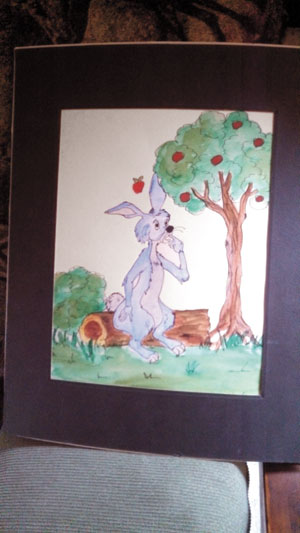Judy sends me two very confusing watercolors, one of a bear and one of a rabbit. Both have the look of Winnie-the-Pooh items. The first piece of a bear is signed A. A. Milne. The other watercolor is a blue rabbit in the style of Rabbit from the creation story by Alan Alexander Milne (1882-1956). But I smell something fishy about these two works.
 Here’s my problems:
Here’s my problems:
- the watercolor is signed A. A. Milne, at first glance an exciting proposition. A. A. Milne was the author/creator of the Pooh books but not, and never was, an illustrator. The famous illustrator from his early books was E. H. Shepard. And Milne did not draw, he wrote.
- The signature of A. A. Milne is a good fake, I believe, and very similar to the author’s signature, but it seems to be signed in graphite. I did a search and signatures by this author are in pen and ink.
- The back has the inscription “Sept 24, 1951” and “Prod. Adv. Only.” This would indicate the watercolor was used in an advertising campaign from the 1950’s. The problem is the watercolor image of the bear isn’t the image of Pooh circa 1951. I even looked into the first Walt Disney use of Pooh, on the “Walt Disney Christmas” on early TV, aired on Dec. 25, 1951.
- Judy’s watercolor bear resembles the look of Pooh as drawn in the 1980’s by a Disney illustrator Stephen Slesinger of Walt Disney Productions, such as in the book How to Catch a Heffalump, the first American edition being January 1989. So the date on the back of 1951 does not match the way Pooh is portrayed on the front, down to the 1980’s red sweater.
Next we turn to the rabbit watercolor.

The rabbit is pictured as blue, and in the Disney years at least, the rabbit called “Rabbit” was yellow. And this rabbit watercolor is not signed and does kind of look like Disney’s rabbit, but not as well drawn. Neither watercolors have the artistry of either Shepard’s early work or Disney artist Slesinger’s later work.
Now let’s look at the real deal, the real collectible ephemera themed all-things Winnie-the-Pooh from the first quarter of the 20th century, with decorations by Ernest H. Shepard, written by A.A. Milne. What do real collectibles by these two geniuses sell for?
First, a little history, A. A. Milne wrote his first book, When We Were Very Young, a book of poetry for his four year old son, when A. A. worked for London’s early Punch magazine in 1924. The first book of Winnie-the-Pooh stories, Now We are Six, came out in 1927. That year Milne’s 11 years old son Christopher Robin was named one of the most famous children in the world from the popularity of his character in his dad’s books. Christopher Robin, in the books, lived deep in the Hundred Acre Wood, in the House at Pooh Corner, built by Christopher Robin and friends for their sad friend Eeyore, with Piglet and Tigger.
The great heyday of Pooh was in 1927-28. Years haven’t taken the shine off Pooh. Even today NEW Pooh merchandise brings in more than $5 billion a year worldwide.
What kind of merchandise does the Pooh image occupy?
Here’s a bit of what’s on eBay now:
- Pooh wheelbarrow blocks
- birthday stamps
- chewable baby books
- Hallmark figures
- finger puppets
- plates with lovely sayings like “Every Cloud has a Honey Lining”
- a clutch wallet
- a musical pop-up train
- (of course) stuffed animals
- bean bags
- Winnie-the-Pooh first birthday cupcake holders
Winnie-the-Pooh’s creator’s home itself, Milne’s home on Mallord Street, London SW3, in the heart of Chelsea London, where he wrote his Pooh books, was sold for $11 million.
Although I don’t think Judy’s watercolors date in their completeness truly to any remanable era of Pooh’s popularity. I’d love to see the signature to make sure. Why? Just suffice to say artists such as Salvator Dali signed thousands of blank artist’s papers before he died, so that his estate could keep the cash flowing. Although confusing to the valuation world, these late works of art (after the artist died) are still worth something…..
So what’s REALLY authentic and hot in A. A. Milne collectible ephemera?
In a word, the original books in great condition. The first trade edition with dust jacket Winnie the Pooh, with Decorations by Ernest H. Shepard, Methuen & Co. Ltd 1926, Octavo, sold for $76,000. The same version in small quarto sold for $66,000. The difference? The octavo is more desirable. The octavo format has eight leaves (folds) per gathering into the binding, and this octavo size has half the page size of the quarto. And, to prove a point, in a set, these books with illustrations are very valuable. The Pooh Books, When We Were Very Young, Winnie-the-Pooh, Now We are Six, and The House at Pooh Corner, the five set sold for $62,000 together in paperback, in their original cloth-backed covers.
Judy, even though the stakes are high there are too many red flags as to fakery on your two watercolors to believe they’re worth much at all